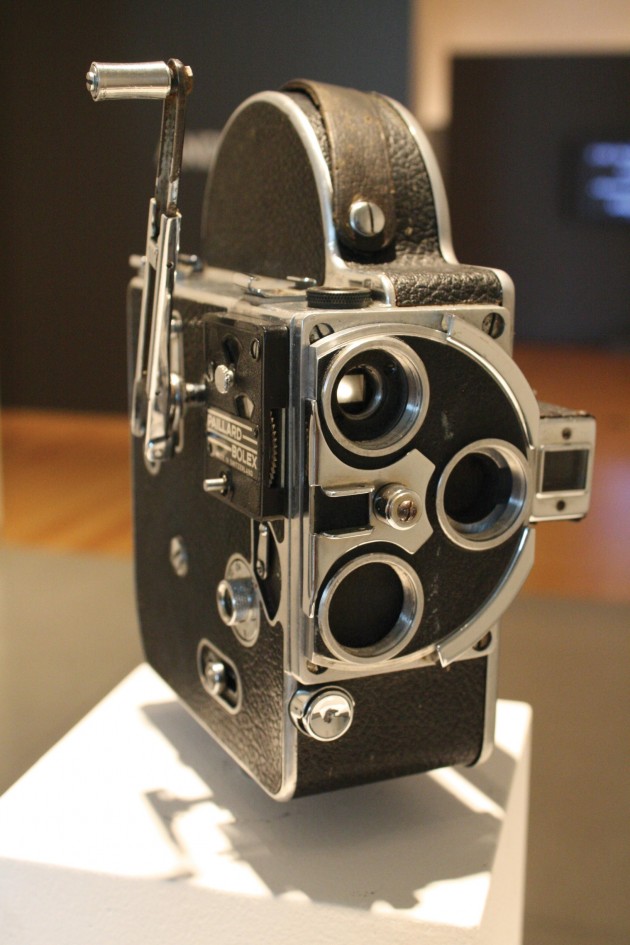
"I am a camera with its shutter open, quite passive, recording, not thinking."
Christopher Isherwood's quotation from the novel "Goodbye to Berlin" welcomes visitors as they peer through the glass doors of Peeler Art Center's latest collection.
Three vintage cameras — a Polaroid Portrait Land, a Minox and a Paillard Bolox — take center stage beyond the quotation in the "Andy Warhol — I am a Camera" exhibit. The trademark recording devices, popularized during Warhol's time, are situated carefully between candid black-and-white photographs on the left and vibrant, colorful snapshots of posed models on the right.
"It's really, really interesting work, some of the best in our permanent collection," said art and art history department chair Michael Mackenzie, noting that it was Peeler's outgoing curator, Katie Johnson, who organized the collection.
"She did a fine job, and I don't imagine how it could get better," Mackenzie said. "It's so well-lit and professional, and it's different from your usual Andy Warhol exhibit in that the main focus is photography."
Mackenzie's favorite portion of the exhibit is the one-of-a-kind Polaroid shots because they evoke a nostalgic 1950's feeling for him, reminiscent of Warhol's Campbell soup can paintings.
"I am a Camera," which opened its doors on Tuesday, is not lacking variety. Just past the cameras are selections of Warhol's photography, characterized by his original quotations.
One display says, "When reporters asked the Pope what he liked best about New York, he replied, ‘Tutti Buoni' — ‘Everything is good.' That's my philosophy exactly."
Rather than showcasing elaborate displays of Times Square or the Statue of Liberty, part of the exhibit features simple images, such as three relatively plain vehicles in an unidentified parking lot with a bland skyscraper and a crane in close proximity.
"He focused on everyday, contemporary experience and the most everyday parts of modern-day life, and he made them seem interesting and complicated," Mackenzie said of Warhol. "He also made it seem like anybody could make art, radically democratizing something that was usually reserved for the elites. I know some people can get frustrated with this art and think, ‘I could do that,' but that's the message."
No two photos in the exhibit are exactly alike. Even a series of snapshots of the same unidentified person feature different leans and stances on the subjects' part. Alongside posed shots is a plethora of candid shots — a man in the midst of a pasta dinner, a woman speaking on a cell phone — that cause ordinary people to stand out in crowds where they would typically blend in. The beating heart of the exhibit is the video screen playing and replaying Warhol's famed silent films, capturing people's faces and presenting a type of "living portrait."
Photography professor Cynthia O'Dell encourages students to experience "I am a Camera."
"This is work you might find at the Art Institute of Chicago or even the Tate in London," O'Dell said. "I just hope students don't take our museums and galleries for granted."
O'Dell added that she hopes people from the Greencastle community feel welcome to visit the selection.
"This exhibit demonstrates Warhol's photographic vision and also illuminates his painting process. Photography was instrumental in helping him critique an American consumerist culture. This exhibit can broaden the average person's perspective on Warhol," O'Dell said. "The Polaroid is also immediate and raw. It is a very different way of working for Warhol. His silkscreens and paintings are often very manipulated and processed. The Polaroid rejects this way of working."
Students, too, appreciated the unusual aspects of the exhibit.
"He's very different from other photographers. Some may see his work as amateur, but I think it's really cool that he doesn't tend to wait for the perfect moment to take a photo or take out different parts of the background," said junior Daniella Smith. "He just takes the photo as he sees it in the moment."
Smith said she enjoyed how organized the "I am a Camera" exhibit appeared and said the layout helps the viewer stay focused on the photography but didn't find the bare white background fitting for the man who led the pop culture movement.
Junior Tina Galindo, a studio art minor, agreed.
"It's very plain, so maybe some more color would be a good change, because [the background] is just white with a little black and it seems kind of boring."
Both students agreed that it takes an open-minded person who genuinely appreciates Andy Warhol or photography to fully enjoy everything the exhibit has to offer.
"Warhol is a unique artist. In many ways he set the tone for Art Star," O'Dell said. "His personality in some ways precedes him. Furthermore, how he constructed his persona is part of his art."
She said the show is professionally installed, and she would not change anything about its operation.
The Peeler Art Center Low Gallery is free to visit and open to the general public. The gallery hours are 10 a.m. to 4 p.m. Monday through Friday, 11 a.m. to 5 p.m. on Saturdays and 1 p.m. to 5 p.m. on Sundays.


